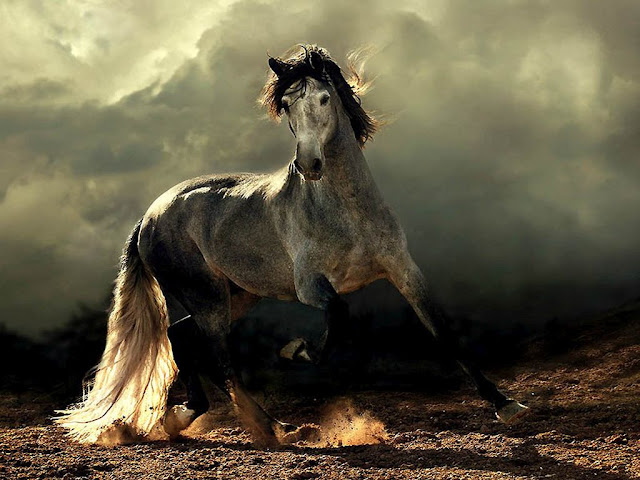(Andalusian Horse)
The Andalusian, also known as the Pure Spanish Horse or PRE (Pura Raza Española), is a horse breed from the Iberian Peninsula, where its ancestors have lived for thousands of years. The Andalusian has been recognized as an individual breed since the 15th century, and its conformation has changed very little over the centuries. Throughout its history, it has been known for its prowess as a war horse, and was prized by the nobility. The breed was used as a tool of diplomacy by the Spanish government, and kings across Europe rode and owned Spanish horses. During the 19th century, warfare, disease and crossbreeding reduced herd numbers dramatically, and despite some recovery in the late 19th century, the trend continued into the early 20th century. Exports of Andalusians from Spain were restricted until the 1960s, but the breed has since spread throughout the world, despite their low population. In 2010, there were more than 185,000 registered Andalusians worldwide. Strongly built, and compact yet elegant, Andalusians have long, thick manes and tails. Their most common coat color is gray, although they can be found in many other colors. They are known for their intelligence, sensitivity and docility. A sub-strain within the breed known as the Carthusian, is considered by breeders to be the purest strain of Andalusian, though there is no genetic evidence for this claim. The strain is still considered separate from the main breed however, and is preferred by breeders because buyers pay more for horses of Carthusian bloodlines. There are several competing registries keeping records of horses designated as Andalusian or PRE, but they differ on their definition of the Andalusian and PRE, the purity of various strains of the breed, and the legalities of stud book ownership. At least one lawsuit is in progress as of 2011, to determine the ownership of the Spanish PRE stud book. The Andalusian is closely related to the Lusitano of Portugal, and has been used to develop many other breeds, especially in Europe and the Americas. Breeds with Andalusian ancestry include many of the warmbloods in Europe as well as western hemisphere breeds such as the Azteca. Over its centuries of development, the Andalusian breed has been selected for athleticism and stamina. The horses were originally used for classical dressage, driving, bullfighting, and as stock horses. Modern Andalusians are used for many equestrian activities, including dressage, show jumping and driving. The breed is also used extensively in movies, especially historical pictures and fantasy epics.
(Shire Horse)
The Shire is a British breed of draught horse.It is a tall breed, and Shires have at various times held world records both for the largest horse and for the tallest horse. The Shire has a great capacity for weight-pulling, and has been popular throughout its history for pulling brewer's drays delivering ale to customers. The horses may also be used for forestry, for riding and for commercial promotion. In 1878, the British organisation now known as the Shire Horse Society was created, with the American Shire Horse Association beginning in 1885. The breed was exported from Britain to the United States in large numbers during the late 19th and early 20th centuries, but popularity fell as mechanisation increased, reaching a low point in the 1950s and 1960s. Popularity began to increase again in the 1970s and after. However, population numbers are still considered to be at critical levels by both the UK-based Rare Breeds Survival Trust and the US-based American Livestock Breeds Conservancy.
(Friesian Horse)
The Friesian is a horse breed originating in Friesland, in the Netherlands. Although the conformation of the breed resembles that of a light draught horse, Friesians are graceful and nimble for their size. It is believed that during the Middle Ages, ancestors of Friesian horses were in great demand as war horses throughout continental Europe. Through the Early Middle Ages and High Middle Ages, their size enabled them to carry a knight in armour. In the Late Middle Ages, heavier, draught type animals were needed. Though the breed nearly became extinct on more than one occasion, the modern day Friesian horse is growing in numbers and popularity, used both in harness and under saddle. Most recently, the breed is being introduced to the field of dressage.
Please Share..





























No comments:
Post a Comment